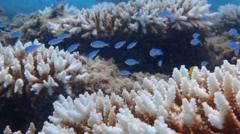Is Western Australia Facing the Worst Coral Reef Bleaching Ever Recorded?

Understanding the Crisis: Coral Bleaching in Western Australia
The coral reefs along the coast of Western Australia (WA) have recently undergone an unprecedented crisis, suffering from the worst bleaching event on record. This calamity is attributed to the state's longest, largest, and most intense marine heatwave, which has alarmed scientists and environmentalists alike. The repercussions of this event are likely to be felt for years to come, as the health of these vibrant ecosystems is crucial not only for marine biodiversity but also for local economies and global climate health.
From August of the previous year to May of this year, warmer water temperatures wreaked havoc on the coral reefs, subjecting them to severe heat stress. This led to a process called bleaching, where corals expel the colorful algae that live in symbiosis with them. Without these algae, corals lose their vibrant colors and, more critically, their source of sustenance. The aftermath of this event spans an astonishing 1,500 kilometers (932 miles), affecting regions that were previously untouched by the impacts of climate change.
The Mechanism of Coral Bleaching
Coral bleaching is a complex phenomenon that occurs when environmental stressors, such as elevated water temperatures, affect the symbiotic relationship between corals and their algae, known as zooxanthellae. These algae provide corals with food through photosynthesis and contribute to their coloration. When water temperatures rise, corals react by expelling the algae, resulting in a stark white appearance. This process can be fatal, especially if the stress persists.
Typically, eight weeks of heat stress is sufficient to kill coral, and early estimates from Australia’s marine science agency indicate that many reefs in WA experienced a mortality rate ranging from 15% to 30%. The length and intensity of this heatwave are unprecedented, with scientists noting that multiple regions were impacted simultaneously. This widespread damage raises significant concerns about the resilience of coral reefs in the face of ongoing climate change.
The Extent of Damage
The Australian Institute of Marine Science (AIMS) recently released a report indicating that the 2024-25 season marked the most severe coral bleaching event on record for the coral reefs in WA. Areas that had previously provided hope—regions like the Rowley Shoals, north Kimberley, and Ningaloo—were hit particularly hard this time around. These locations had historically shown resilience to bleaching but are now experiencing the devastating effects of climate change.
As James Gilmour from AIMS notes, climate heating has finally caught up with these reefs. The implications of this event extend beyond just ecological concerns; they also encompass economic, social, and cultural dimensions. Coral reefs play a vital role in supporting fisheries, tourism, and coastal protection, making their health crucial for local communities and economies.
The Role of Climate Change
Climate change remains the primary threat to coral reefs globally. Rising ocean temperatures, altered salinity levels, and increased ocean acidification have all contributed to the increased frequency, intensity, and spread of coral bleaching events. The current two-year-long global coral bleaching event underscores the urgency of addressing climate change through reduced carbon emissions and sustainable practices.
Dr. Gilmour emphasizes that coral reefs require 10 to 15 years to recover fully from bleaching events. Unfortunately, the increasing frequency of these events leaves little room for recovery. The ongoing crisis serves as a stark reminder that immediate action is necessary to mitigate the impacts of climate change on marine ecosystems.
What Can Be Done?
Addressing the crisis facing coral reefs requires a multifaceted approach that involves both local and global efforts. Here are some strategies that can help protect and restore coral reefs:
- Reduce Carbon Emissions: The most significant step in combating climate change is to reduce carbon emissions on a global scale. This can be achieved through transitioning to renewable energy sources, improving energy efficiency, and promoting sustainable transportation.
- Implement Marine Protected Areas: Establishing marine protected areas can help safeguard vital ecosystems from overfishing and other human activities that exacerbate stress on coral reefs.
- Support Coral Restoration Projects: Engaging in coral restoration initiatives can help rehabilitate damaged reefs. These projects often involve planting coral larvae and promoting healthy marine environments.
- Promote Sustainable Fishing Practices: Sustainable fishing practices can reduce overfishing and allow coral ecosystems to recover. This includes implementing catch limits and protecting breeding grounds.
- Enhance Public Awareness: Educating communities about the importance of coral reefs and the impacts of climate change can foster a sense of responsibility and encourage conservation efforts.
Future Outlook for Coral Reefs
The current state of coral reefs in Western Australia serves as a warning about the future of marine ecosystems worldwide. The combination of climate change and other anthropogenic pressures could lead to irreversible damage unless swift action is taken. Without immediate interventions, we risk losing these vital ecosystems, which provide critical habitat for countless marine species and essential services for human populations.
Moreover, the loss of coral reefs would have cascading effects on biodiversity, fisheries, and coastal protection. Given the integral role that coral reefs play in marine ecosystems and human livelihoods, it is imperative that we act decisively to address the challenges they face.
FAQs About Coral Bleaching
What causes coral bleaching?
Coral bleaching is primarily caused by environmental stressors, such as elevated water temperatures, increased salinity, and pollution. These factors disrupt the symbiotic relationship between corals and their algae, leading to the expulsion of the algae and subsequent bleaching.
How can coral reefs recover from bleaching?
Coral reefs can recover from bleaching if the environmental conditions improve and the corals are given enough time to heal. However, this recovery process can take 10 to 15 years, depending on the severity of the bleaching and the overall health of the ecosystem.
Why are coral reefs important?
Coral reefs are crucial for biodiversity, providing habitat for numerous marine species. They also support fishing industries, boost tourism, and protect coastlines from erosion. The health of coral reefs is directly linked to the wellbeing of many communities around the world.
What can individuals do to help protect coral reefs?
Individuals can contribute to coral reef protection by reducing their carbon footprint, supporting sustainable seafood choices, and advocating for marine conservation policies. Educational outreach and community engagement can also play a vital role in protecting these ecosystems.
The crisis facing coral reefs in Western Australia is a wake-up call for all of us. Our actions today will determine the fate of these vital ecosystems tomorrow. Will we take the necessary steps to protect our oceans, or will we allow climate change to dictate their future? #CoralReefs #ClimateChange #MarineConservation
Published: 2025-08-12 03:35:21 | Category: technology



